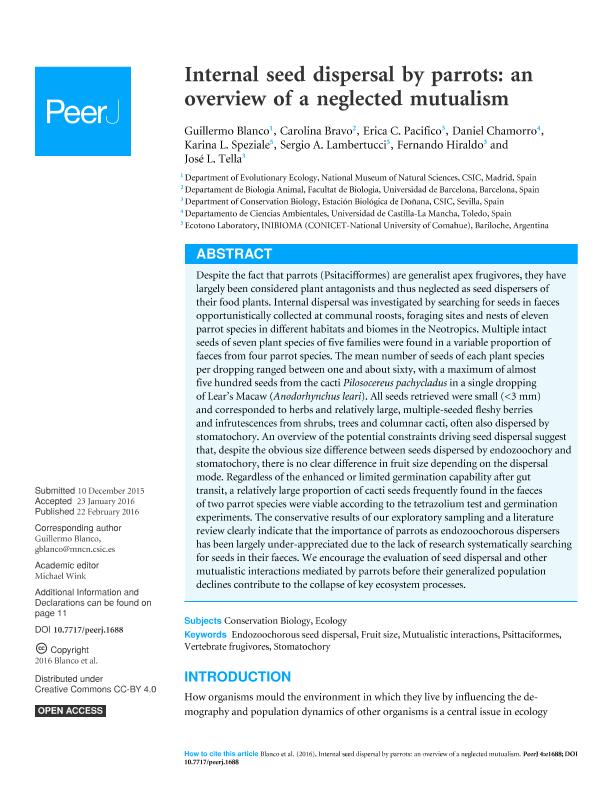Mostrar el registro sencillo del ítem
dc.contributor.author
Blanco, Guillermo

dc.contributor.author
Bravo, Carolina
dc.contributor.author
Pacífico, Erica C.
dc.contributor.author
Chamorro, Daniel
dc.contributor.author
Speziale, Karina Lilian

dc.contributor.author
Lambertucci, Sergio Agustin

dc.contributor.author
Hiraldo, Fernando

dc.contributor.author
Tella Escobedo, José Luis

dc.date.available
2018-10-12T17:46:46Z
dc.date.issued
2016-02-22
dc.identifier.citation
Blanco, Guillermo; Bravo, Carolina; Pacífico, Erica C.; Chamorro, Daniel; Speziale, Karina Lilian; et al.; Internal seed dispersal by parrots: An overview of a neglected mutualism; PeerJ Inc.; PeerJ; 2016; 2; 22-2-2016; 1-16
dc.identifier.issn
2167-8359
dc.identifier.uri
http://hdl.handle.net/11336/62346
dc.description.abstract
Despite the fact that parrots (Psitacifformes) are generalist apex frugivores, they have largely been considered plant antagonists and thus neglected as seed dispersers of their food plants. Internal dispersal was investigated by searching for seeds in faeces opportunistically collected at communal roosts, foraging sites and nests of eleven parrot species in different habitats and biomes in the Neotropics. Multiple intact seeds of seven plant species of five families were found in a variable proportion of faeces from four parrot species. The mean number of seeds of each plant species per dropping ranged between one and about sixty, with a maximum of almost five hundred seeds from the cacti Pilosocereus pachycladus in a single dropping of Lear's Macaw (Anodorhynchus leari). All seeds retrieved were small (< 3 mm) and corresponded to herbs and relatively large, multiple-seeded fleshy berries and infrutescences from shrubs, trees and columnar cacti, often also dispersed by stomatochory. An overview of the potential constraints driving seed dispersal suggest that, despite the obvious size difference between seeds dispersed by endozoochory and stomatochory, there is no clear difference in fruit size depending on the dispersal mode. Regardless of the enhanced or limited germination capability after gut transit, a relatively large proportion of cacti seeds frequently found in the faeces of two parrot species were viable according to the tetrazolium test and germination experiments. The conservative results of our exploratory sampling and a literature review clearly indicate that the importance of parrots as endozoochorous dispersers has been largely under-appreciated due to the lack of research systematically searching for seeds in their faeces. We encourage the evaluation of seed dispersal and other mutualistic interactions mediated by parrots before their generalized population declines contribute to the collapse of key ecosystem processes.
dc.format
application/pdf
dc.language.iso
eng
dc.publisher
PeerJ Inc.
dc.rights
info:eu-repo/semantics/openAccess
dc.rights.uri
https://creativecommons.org/licenses/by-nc-sa/2.5/ar/
dc.subject
Endozoochorous Seed Dispersal
dc.subject
Fruit Size
dc.subject
Mutualistic Interactions
dc.subject
Psittaciformes
dc.subject
Stomatochory
dc.subject
Vertebrate Frugivores
dc.subject.classification
Otras Ciencias Biológicas

dc.subject.classification
Ciencias Biológicas

dc.subject.classification
CIENCIAS NATURALES Y EXACTAS

dc.title
Internal seed dispersal by parrots: An overview of a neglected mutualism
dc.type
info:eu-repo/semantics/article
dc.type
info:ar-repo/semantics/artículo
dc.type
info:eu-repo/semantics/publishedVersion
dc.date.updated
2018-09-24T13:53:21Z
dc.journal.volume
2016
dc.journal.number
2
dc.journal.pagination
1-16
dc.journal.pais
Estados Unidos

dc.journal.ciudad
Nueva York
dc.description.fil
Fil: Blanco, Guillermo. National Museum of Natural Sciences; España
dc.description.fil
Fil: Bravo, Carolina. Universidad de Barcelona; España
dc.description.fil
Fil: Pacífico, Erica C.. Estación Biológica de Doñana; España
dc.description.fil
Fil: Chamorro, Daniel. Universidad de Castilla-La Mancha; España
dc.description.fil
Fil: Speziale, Karina Lilian. Consejo Nacional de Investigaciones Científicas y Técnicas. Centro Científico Tecnológico Conicet - Patagonia Norte. Instituto de Investigaciones en Biodiversidad y Medioambiente. Universidad Nacional del Comahue. Centro Regional Universidad Bariloche. Instituto de Investigaciones en Biodiversidad y Medioambiente; Argentina
dc.description.fil
Fil: Lambertucci, Sergio Agustin. Consejo Nacional de Investigaciones Científicas y Técnicas. Centro Científico Tecnológico Conicet - Patagonia Norte. Instituto de Investigaciones en Biodiversidad y Medioambiente. Universidad Nacional del Comahue. Centro Regional Universidad Bariloche. Instituto de Investigaciones en Biodiversidad y Medioambiente; Argentina
dc.description.fil
Fil: Hiraldo, Fernando. Estación Biológica de Doñana; España
dc.description.fil
Fil: Tella Escobedo, José Luis. Estación Biológica de Doñana; España
dc.journal.title
PeerJ
dc.relation.alternativeid
info:eu-repo/semantics/altIdentifier/doi/https://dx.doi.org/10.7717/peerj.1688
dc.relation.alternativeid
info:eu-repo/semantics/altIdentifier/url/https://peerj.com/articles/1688/
Archivos asociados
